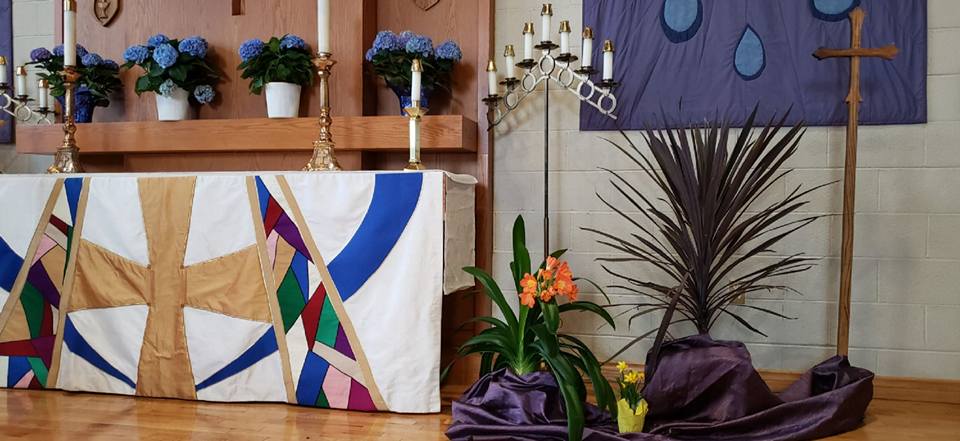Sunday, August 8, 2021
Ephesians 4:25 – 5:2
John 6:35, 41-51
If you do some digging into early Christian history, I think you’ll find that the first few hundred years of the Church are often most exciting to learn about. It was a dangerous time (illegal to be Christian), but fruitful — maybe because of that — for making new Christians. But in this time of illegality there were lots of misunderstandings and suspicions about this new religious sect: they tended to meet at night, under cover of darkness. They called each others ‘sister’ and ‘brother’ and shared a kiss of peace. (We shake hands these days — or hopefully one day will again.) They were considered atheists, because they didn’t believe in the pantheon of Roman or Greek gods. And they were cannibals — you heard it from a friend of a friend of someone’s cousin — because they ate flesh and drank blood. It was a time of misunderstandings, and martyrdom.
To speak anything, or even just to exist in relationship with someone else, one risks being misunderstood. That Ephesians reading might have something helpful to say to that: how we are “members of one another;” and not to let the sun go down on our anger, and to “live in love, as Christ loved us and gave himself up for us, a fragrant offering and sacrifice to God.” (We might ask ourselves what misunderstandings and conflicts precipitated the writing of the letter.) And as history went on, it was often language and ideas around “sacrifice” (vis-a-vis the Eucharist) that led to misunderstandings (and martyrdom) not between the Church and the world, but amongst Christians themselves. To our shame.
Thousands of pages have and could be written on this, and don’t worry, they won’t all be covered in the next three minutes. But something — one little thing — that we might find helpful is an approach laid out by a Jesuit author [Tad Guzie] I was reading, which can apply to our exploration of communion, or really, of anything. He says that we first ask a clear empirical question: “what is it?” And then the follow-up is a bit deeper: “what does it mean [or symbolize]” So take an everyday example: the sun. What is it? The sun, a ball of gas. What does it mean for us? Well, light, warmth, and the possibility of our existence and thriving on this planet. Or think of someone giving flowers to their loved one: What is it? A bouquet of roses. What do they mean? “I love you.”
We get into trouble when those deeper, more mysterious, engaging second questions get treated like the first one. The crowd in the gospel reading today got caught up in that. (‘How can this guy be bread from heaven, when we know his family, and they’re people, not pastries?!) Or we might also get in trouble when we disregard the second question as meaningless, because the sun’s light and warmth are, in fact, real, and important.
There are some traditions that, out of a desire for certainty and control, try to get at the meaning of the Eucharist by asking those first level questions of ‘what is this’ instead of going deeper to ‘what does this mean.’ Our theologically diverse, accommodating, and sometimes muddy Anglican tradition shies away from over-explaining. So rather than get stuck on first-level questions around formulas or pinpointing the moment of consecration, we might remember words attributed to Elizabeth I:
Twas God the Word that spake it,
He took the Bread and brake it:
And what that Word did make it,
That I believe and take it.
Or, Jesus whom we heard say this morning: “This is the bread that comes down from heaven, so that one may eat of it and not die. I am the living bread that came down from heaven. Whoever eats of this bread will live forever; and the bread that I will give for the life of the world is my flesh.”
We are all looking for a faith that speaks to us, and actually seems to reach into us in our everyday lives. And something we can do is consider how the Body of Christ, or the sacrifice of Christ might be meaningful, and present to us today. We could point to the Cross, and see the Body of Christ there. We could point to the altar, and find the Body of Christ on it. But if we stop there, it might be hard to figure out the connection between the two. Our bridge might be remembering, as Paul said, that we’re members of one another, and, as Church, “the Body of Christ.” And the sacrifice of the Cross and the sacrifice of the Mass are bridged by the sacrifice of the Church, in praise and thanksgiving. When we come together in whatever way possible — and I hope soon it will be ‘in the flesh’ — we are a living memory shaped into people able to take the message of Jesus into our world, that life is found in him. And without over-explaining things, I do truly believe that just as Jesus gathered people at table in his life, and continued to do so after being raised from the dead, so he is present to and with us in our own time. Maybe immeasurable and hard to describe, but nevertheless, truly meaningful and very real.
© 2021 The Rev’d Matthew Kieswetter
[The Jesuit author mentioned is Tad Guzie in his Jesus and the Eucharist (New York: Paulist Press, 1974)
